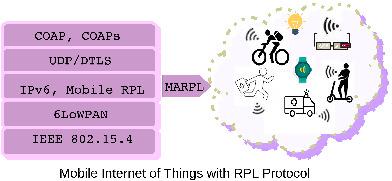当前位置:
X-MOL 学术
›
Trans. Emerg. Telecommun. Technol.
›
论文详情
Our official English website, www.x-mol.net, welcomes your
feedback! (Note: you will need to create a separate account there.)
MARPL: A crosslayer approach for Internet of things based on neighbor variability for mobility support in RPL
Transactions on Emerging Telecommunications Technologies ( IF 2.5 ) Pub Date : 2020-03-23 , DOI: 10.1002/ett.3931 Janine Kniess 1 , Vinicius de Figueiredo Marques 1
Transactions on Emerging Telecommunications Technologies ( IF 2.5 ) Pub Date : 2020-03-23 , DOI: 10.1002/ett.3931 Janine Kniess 1 , Vinicius de Figueiredo Marques 1
Affiliation

|
Internet of things (IoT) proposes the use of devices with low energy capacity, processing, and memory power for a range of applications such as environmental monitoring and smart health. Such devices usually have sensing and wireless communication capabilities. Low power and lossy networks on mobile devices are a common type of wireless network in IoT applications. This article proposes the mobility aware RPL (MARPL), which is an extension of the IPv6 routing protocol for low‐power and lossy network (RPL) in order to enhance its performance in networks with mobile nodes. The mobility of nodes increases packet loss in the canonical RPL protocol. The MARPL mobility mechanism adopts a crosslayer approach. The network layer uses signal strength measurements from the media access layer to calculate a node's variability neighborhood. Performance evaluation results obtained by the Cooja simulator confirm the effectiveness of MARPL regarding link disconnection prevention, packet delivery rate, low overhead, and energy consumption when compared with other protocols.
中文翻译:

MARPL:一种基于邻居可变性的物联网跨层方法,用于RPL中的移动性支持
物联网(IoT)提议将低能量,低处理和低存储能力的设备用于一系列应用,例如环境监控和智能健康。此类设备通常具有感应和无线通信功能。移动设备上的低功耗和有损网络是物联网应用中常见的无线网络类型。本文提出了移动感知RPL(MARPL),它是针对低功耗有损网络(RPL)的IPv6路由协议的扩展,目的是增强其在具有移动节点的网络中的性能。节点的移动性增加了规范RPL协议中的数据包丢失。MARPL移动性机制采用跨层方法。网络层使用来自媒体访问层的信号强度测量来计算节点的可变性邻域。
更新日期:2020-03-23
中文翻译:

MARPL:一种基于邻居可变性的物联网跨层方法,用于RPL中的移动性支持
物联网(IoT)提议将低能量,低处理和低存储能力的设备用于一系列应用,例如环境监控和智能健康。此类设备通常具有感应和无线通信功能。移动设备上的低功耗和有损网络是物联网应用中常见的无线网络类型。本文提出了移动感知RPL(MARPL),它是针对低功耗有损网络(RPL)的IPv6路由协议的扩展,目的是增强其在具有移动节点的网络中的性能。节点的移动性增加了规范RPL协议中的数据包丢失。MARPL移动性机制采用跨层方法。网络层使用来自媒体访问层的信号强度测量来计算节点的可变性邻域。









































 京公网安备 11010802027423号
京公网安备 11010802027423号